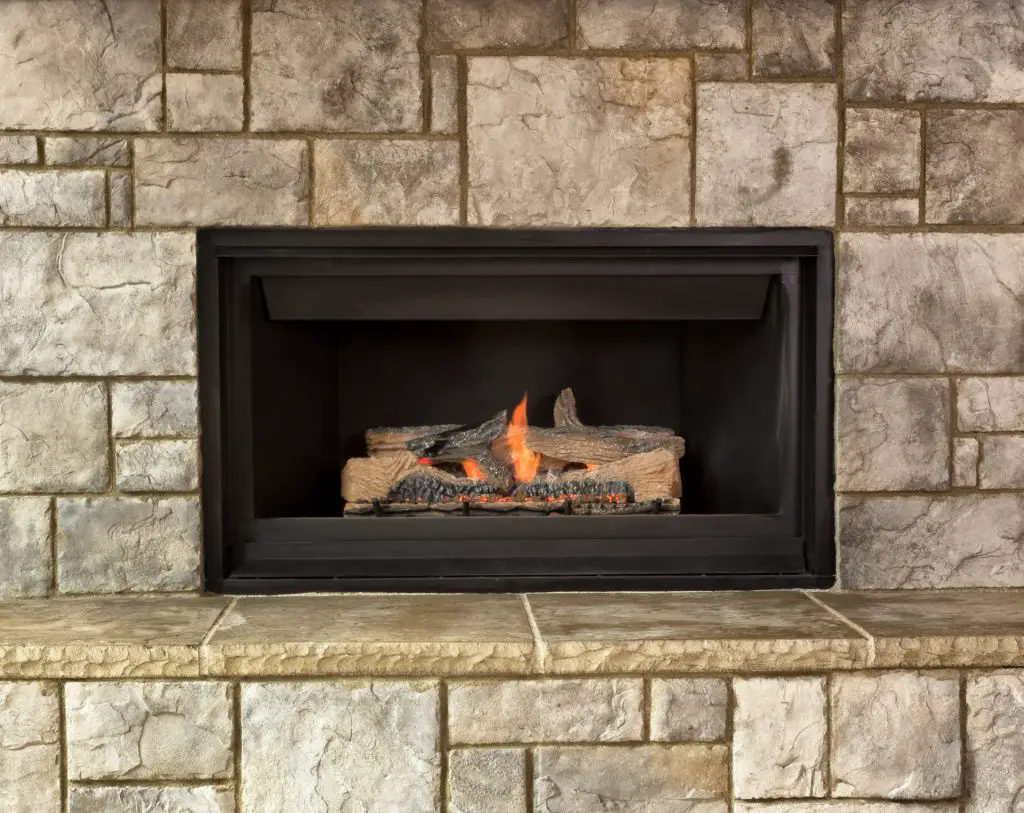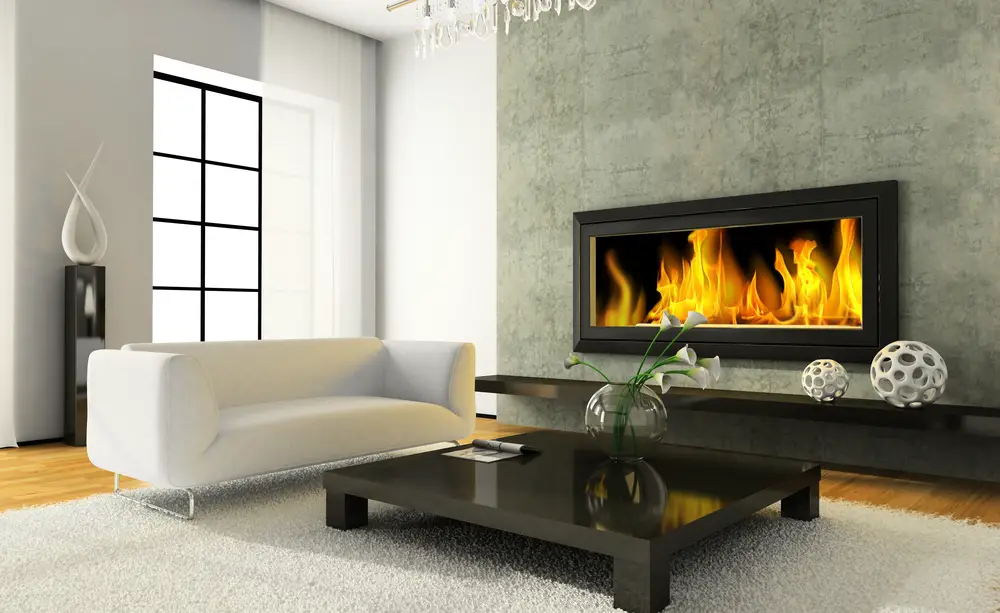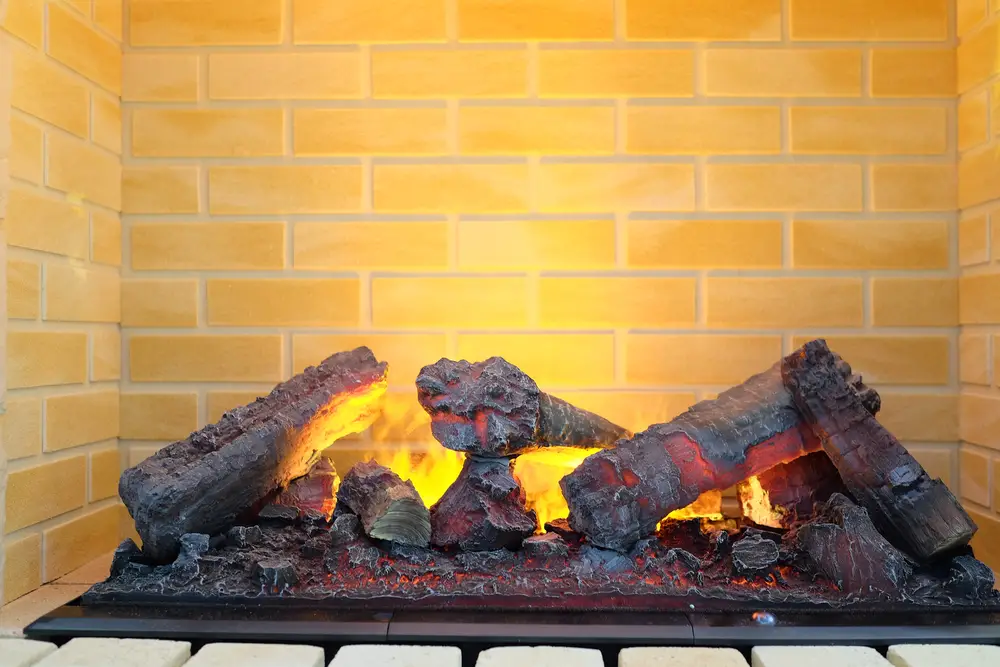I am really grateful to have a gas fireplace in my home. It has been a wonderful addition to our living room:
We decided to put our fireplace in the living room because it’s the most used room in the house. We wanted it to be an inviting space for friends and family alike.
A gas fireplace is a low-maintenance and efficient heating solution. It provides a warm and cozy feeling to the room. Plus, it’s an efficient alternative to wood-burning fireplaces.
Gas fireplace installation is also quite easy and cost-effective. Plus, there are no sparks or smoke from the gas fire to worry about!
The 3 Main Styles
The 3 main styles of gas fireplaces – Direct Vent, Ventless (Vent-Free), and B-Vent. But which one is the best?
Contents
- Direct Vent Fireplaces
- What are they?
- How do they work?
- Who are they good for?
- Ventless Fireplaces
- What are they?
- How do they work?
- Who are they good for?
- B-VENT GAS FIREPLACES
- What are they?
- How do they work?
- Who are they good for?
- Types Of Design & Installation Styles
- Inserts
- Built-In
- Log Sets
- Gas Fireplace Considerations
- Should I Install My Own Fireplace?
- How much is care and maintenance?
- Is a Vented or Ventless Gas Fireplace Better?
- Gas Fireplace Explosions
- How many BTUs?
- Features To Consider
Direct Vent Fireplaces
A direct vent fireplace is one of the most common types of fireplaces due to its efficiency rating and safety features.
What are they?
A vented fireplace is just what the name suggests, a fireplace that needs some sort of ventilation to work properly. There are many fireplace types with various venting options on the market. Unlike a traditional wood-burning fireplace that has a chimney, a direct vent fireplace the vent is routed through the walls horizontally.
How do they work?
A Direct Vent Fireplace works by having two chambers that work in unison to create a cycle. One of the chambers draws in air from outside into a firebox to create combustion whilst the other box works to expel the created exhaust and gases.
The second chamber works to bring in indoor air to circle around the heated firebox and to later be fanned out as further heat output to the room the fireplace is in. The chambers work in tangents to create an effective heating source.
With the flexible installation process, with various venting options. There is co-linear and co-axial venting that both can work in your direct vent gas fireplace:
- Co-Linear works by having the vent and intake liners parallel to each other and use flexible chimney liners. Almost all of these installations occur in a masonry chimney.
- Co-Axial has both of the pipes in one another. This allows airflow while preventing heat transfer to surrounding combustible structures.
Who are they good for?
Vent fireplaces are a good fit for most households that want better heating efficiency at a safer rate. Unlike other options, a vented fireplace allows you to have a more realistic, less blue flame and lower burn temperature.
Ventless Fireplaces
What are they?
This vent-free unit pipes natural gas or propane into a gas fireplace to create a more heat-efficient option than its vent sibling. Ventless gas fireplaces are meant to produce fewer fumes and exhaust and thus can go without having a vent.
How do they work?
Ventless gas fireplaces are connected directly to your gas line or propane tank. They work in the same fashion as other appliances that burn gas cleanly, leaving almost no trace of fumes.
The fireplace also has noncombustible logs that help to heat the home. They’re fitted with holes to help the beautiful flames come up without issue.
Since there is no vent, the fireplace works in a U-shape taking oxygen from the room. This oxygen is then mixed with the gas to create combustion. There is an opening on the top of the fireplace that expels the hot air back into the room to further heat output.
Who are they good for?
Ventless Gas Fireplaces are becoming more popular in new homes. The way new homes are structured doesn’t really allow
Be warned, some states have banned the installation of a ventless fireplace, and HUD buildings also do not permit them. There are also still little levels of fumes leaked out from the fireplace.
B-VENT GAS FIREPLACES
What are they?
Also known as a natural vent, B-Vent fireplaces are an inexpensive alternative to the other two options. Usually, installing this type of fireplace is very easy and proves to work just as well as other vented fireplaces.
How do they work?
Natural vent options work by pulling air from indoor and will later be pushed outdoors. This type of venting requires a chimney with a double-wall pipe. While the combustion gases are working in the firebox, the fumes and exhaust naturally work their way up through the piping and outside.
There are two settings in which you can leave your B-vent fireplace on throughout the year:
- Intermittent Pilot Ignition (IPI) works to electronically ignite your pilot flame. In this mode, your pilot light is present only when your main burner is working. This means that it works to see energy while still providing an immediate ignition.
- Continuous Pilot Ignition (CPI) works almost the same as IPI except the pilot flame will stay on even when the main burner is not active. This allows for an even faster operation than the first by maintaining drafts and minimizing moisture in the burner.
Who are they good for?
Natural gas fireplaces are a great choice for those that want an affordable option since installation is pretty easy and can be used with an existing fireplace. The fireplaces also have larger flames than the other two options because they rely on indoor air.
Types Of Design & Installation Styles
Inserts

If you currently do not have a gas fireplace but want one in your home, you can always get a gas fireplace insert. These inserts are used to convert your old, traditional fireplace into a gas fireplace. In this blog, we will be looking at the vent and ventless fireplace inserts that you can put in your home.
- Direct vent gas fireplace inserts are easiest to install when you have an existing chimney. Compared to the ventless option, it is more expensive to install and you lose that flexibility of placement that your get with a ventless option.
- Vent-free gas fireplace inserts are the more affordable and flexible option since there is no vent required. There are still many restrictions on ventless inserts because of safety concerns.
Built-In

Unlike an insert, a built-in fireplace does not require an existing wood-burning fireplace to be in your home. These fireplaces come in vent and ventless options and if you have a bigger budget, might be perfect for you.
Log Sets

Depending on what kind of set-up you decide to go with, there are various log sets that will come with your fireplace. Unlike a wood-burning fireplace, a gas fireplace uses natural gases. These logs are usually ceramic and have piping that comes from them to produce a flame. The gas logs not only provide a traditional look to your fireplace but help to retain heat that will be pushed out into your home.
If you do not want to use gas logs in your fireplace, there are some alternatives you can implement:
- Fire Glasses are small pieces of tempered glass used in fireplaces for both aesthetic and functional purposes. The glass is also recycled which makes it a better alternative for the environment.
- Coal and coal buckets are a great alternative for smaller fireplaces that log accommodations will not fit in. They can only be used with vented fireplaces!
- Lava Stone is great for retaining heat in your fireplace and saving money.
Gas Fireplace Considerations
Should I Install My Own Fireplace?
You might be tempted to install your own fireplace to mitigate costs but you risk way more than you receive in the long run. Many professionals will advise against you installing your own in because of all of the safety risks you can face.
The average cost for professional installation
The typical range to installing a professional gas fireplace is anywhere between $400 to $4,000 but can go as high as ten thousand.
A direct-vent option can vary in price only because there are a couple of options. If you just want to install gas logs, the cost can be anywhere from $200 to $1,000 whereas, the whole unit can run you $2,000 to $5,000, not including professional installation.
With ventless gas, fireplaces can run up, on average, $3,500 but there are still other factors that can raise the price. Installation can be pricey, and if indoor ventilation is lacking, that can be tacked on to the bill.
Removing a gas fireplace place, as well, can be pretty tricky- so make sure you understand what you’re getting into!
How much is care and maintenance?
Both vent and ventless gas fireplaces need to be regularly maintained to work properly and last longer. For both units, it is important to follow safety measures like ensuring the gas is completely off before you continue with your maintenance and care.
Vented Gas Fireplaces have a couple more components to their ventless partners. There is the chimney or vents, the firebox, gas burner and, if you are using logs, that will all need to be cleaned and inspected before further use. Since the vents are the more important component of these fireplaces, taking extra precautions to ensure that pipes are correctly connected and inspected. It’s also important to clean your chimney or vents at least once a year to clear any backup of ash or creosote.
Ventless fireplaces are a bit easier to maintain since there are no vents to worry about. It is important to take any logs or stones out of your firebox before cleaning. Cleaning out your ventless fireplace is important for safety reasons and efficiency.
Is a Vented or Ventless Gas Fireplace Better?
Comparing vented and ventless gas fireplaces, it is important to look at your own personal preferences and budget for the best options.
Depending on if you already have a wood fireplace or if you have a higher budget to install a built-in system, you might want to consider a vented gas fireplace. These fireplaces are the safer option of the two because there is an outdoor ventilation system that helps keep harmful fumes and toxins out of your home. There is also a tempered glass panel that separates you from the real flame so that you stay safe.
If you need a more affordable option, ventless fireplaces can be very affordable and can work with your home. Since there is no outdoor vent, it is easy to install it in any part of your home. Not only this but it becomes a cheaper option for those that still want the feel of a cozy fireplace in their home.
The big problems that you can run into with a ventless fireplace, are the risk of fumes and gas odors traveling in your home and many restrictions that are placed on them for safety. Some states have even banned these fireplaces because of risk.
Gas Fireplace Explosions
Gas fireplaces can explode and cause sudden fires, although this is rare. Gas can build up and explode if the pilot light isn’t properly positioned when the gas starts to flow. To prevent this, it is important to check the pilot light regularly (Source).
How many BTUs?
Fireplace heat output is determined through British Thermal Units (BTU). BTU is calculated by how much heat is required to heat 1 pound of water by 1 degree Fahrenheit.
A fireplace’s BTU also matters because it can determine the cost that you will pay monthly. If you’re using liquid propane as your gas source, you can multiply the fireplace BTU by the cost per gallon and divide that by the BTU equivalent where you live.
A vented gas fireplace can range from 18,000 to 60,000-BTU output. With this wide range, vent gas fireplaces have more ways to differentiate heat making it a much more efficient way to heat your home. Ventless gas fireplaces can get up to 36,000-BTU output which is far less than vented ones.
Features To Consider
Now you have looked at all of the ups and downs of both ventless and vented fireplaces, but what features should you consider when you finally make that purchase:
- Battery Backup: A backup battery might be helpful if your power ever goes out in your home. If your fireplace has an IPI, batter backup options can be helpful since this needs an electronic ignition. You won’t have to worry about this much if you have a standing pilot light. This is pretty important- check out whether gas fireplaces need electricity to understand this topic better.
- Built-in Fan: A built-in fan works best for a ventless fireplace that needs that extra push to ventilate the indoor air in your space.
- LED Accent Lighting: Accent lights are a great addition to add more to your fireplace. Although the fireplace is the center of your decor, the lights just add more depth to your space.
- Electronic Ignition: Also known as IPI, electronic ignition is great because it is an energy-efficient way to light your fireplace without keeping your pilot light on all the time.
- Wall-Thermostat Control: A wall thermostat will help automatically set the temperature of your fireplace. You can also manually change the temperature will a remote control or on the thermostat. (Learn more about cleaning the thermocouple here)
- Variable-Flame Height Adjustment: This allows you to control the height of the flame in your fireplace. Look for units that adjust down to 30 percent of full output.

